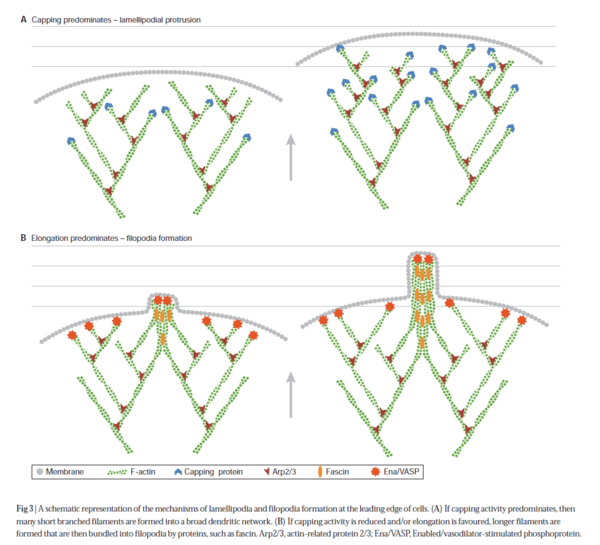Cellular regulation of fascin protrusions
In living cells and tissues, actin nucleation and filament reorganization are controlled spatially and temporally by extracellular cues and the activities of cell-signaling pathways. In the assembly of protrusions in which actin is bundled by fascin, extracellular matrix (ECM) components such as TSP-1, TSP-2 and tenascin-C activate stable bundling. TSP-1 and TSP-2 are homotrimeric glycoproteins in which each subunit contains multiple domains with the capacity to interact with cell surfaces. Systematic analysis of a panel of recombinant protein units of TSP-1 and TSP-2 identified that cell spreading and assembly of fascin protrusions depends on trimeric assembly of the type-3 repeats and globular C-terminal domain (GCT). These domains form the most highly conserved region, which is present in all members of the thrombospondin family in both vertebrates and invertebrates. A second major area of interest with regard to the regulation of fascin by the ECM centers on the mechanisms by which cell protrusions and contractile adhesions are coordinated to mediate appropriate static or migratory cell behaviors. In a demonstration of the functional inter-connection of protrusions with cell-tractional force, adherent cells constrained on square islands were found to preferentially extend cell protrusions containing actin or fascin at their corners, which were also the sites where cell-tractional forces were concentrated. Brief pharmacological inhibition of components of the contractile apparatus blocked actin-containing protrusions, which is indicative of a functional linkage. Much remains to be learnt about the molecular basis of the functional integration of different forms of adhesions.TSP-1 and FN induce distinct intracellular signals with regard to the activation of small GTPases and PKCa, the latter being the mediator of fascin phosphorylation in FNadherent cells. As detected in live cells by FRET (fluorescence resonance energy transfer), FLIM (fluorescence lifetime imaging microscopy), coimmunoprecipitation from cell extracts, and protein–protein binding in vitro, activated PKCa preferentially binds to phosphorylated fascin or to an S39D, phosphomimetic mutant form. Specific blockade of the phosphofascin/ PKCa interaction with a membrane-permeable TAT/ fascin-S39D peptide resulted in increased rates of cell migration on FN in conjunction with increased numbers of fascin protrusions and remodelling of focal adhesions. Thus, the binding of fascin and PKCa represents a point of intersection that regulates the balance between contractile adhesions and protrusions and thereby modulates cell migratory behavior. It is now clear that regulation of fascin is not only conducted from the ECM. Insulin-like growth factor I (IGF-I) and nerve growth factor (NGF) also act as inducers of fascin protrusions. IGF-I has endocrine and paracrine roles in normal breast physiology and alterations in the level of IGF-I or its receptor are involved in breast cancer. In MCF-7 breast carcinoma cells engineered to over-express wild-type or kinase-dead forms of IGF-I receptor (IGF-IR), IGF-I rapidly induced dynamic microspike cell protrusions and ruffles supported by cortical fascin-and-actin bundles. A requirement for actin-bundling by fascin for the formation of the protrusions is very likely but remains to be experimentally proven. Certainly, the formation of the protrusions, fascin redistribution and initial cell migration were all completely dependent on IGF-IR tyrosine kinase activity and were mediated by a phosphatidylinositol-3-kinase-dependent process. In further mechanistic studies, a-actinin, which localizes to the bases of the bundles, was also found to contribute to the IGF-I-dependent assembly of microspikes.
The p75 neurotrophin receptor (p75 NTR) is expressed by many human melanomas. Treatment of melanoma cells with NGF resulted in a rapid induction of fascin microspikes, followed by cell migration. Migration depended on the actin-bundling activity of fascin: expression of S39D mutant fascin (i.e. a non-actin-bundling form) blocked the migration response to NGF, whereas over-expression of wild-type fascin did not. Interestingly, fascin was shown to bind to the cytoplasmic domain of p75NTR and to coimmunoprecipitate with endogenous p75NTR, suggesting a direct mechanism for recruitment of fascin at cell margins that would facilitate rapid microspike assembly (Adams, 2004).
